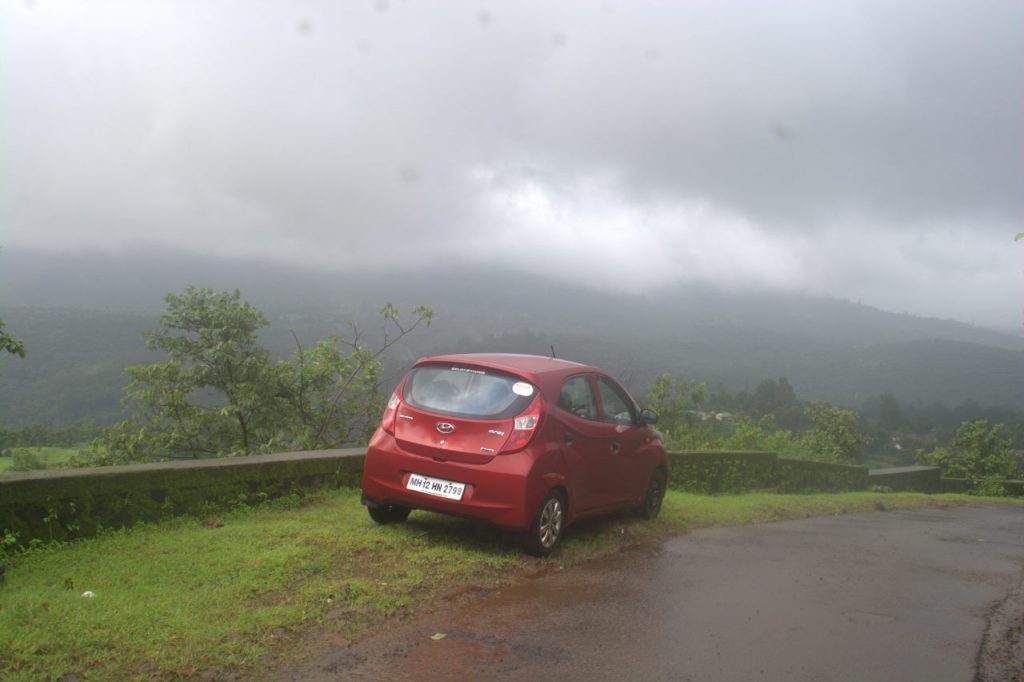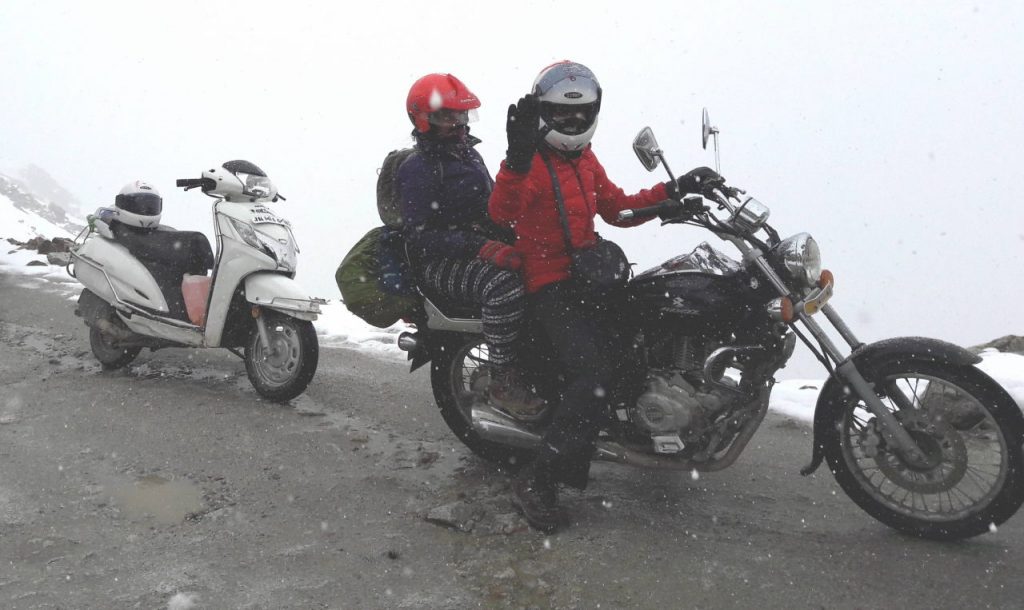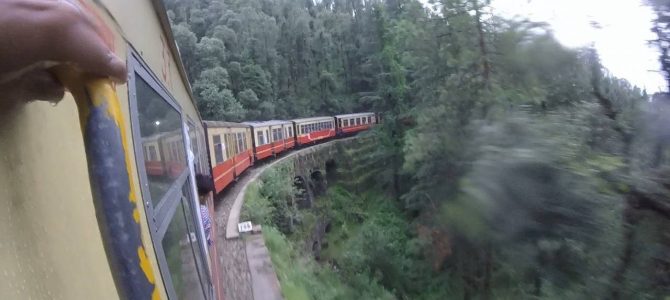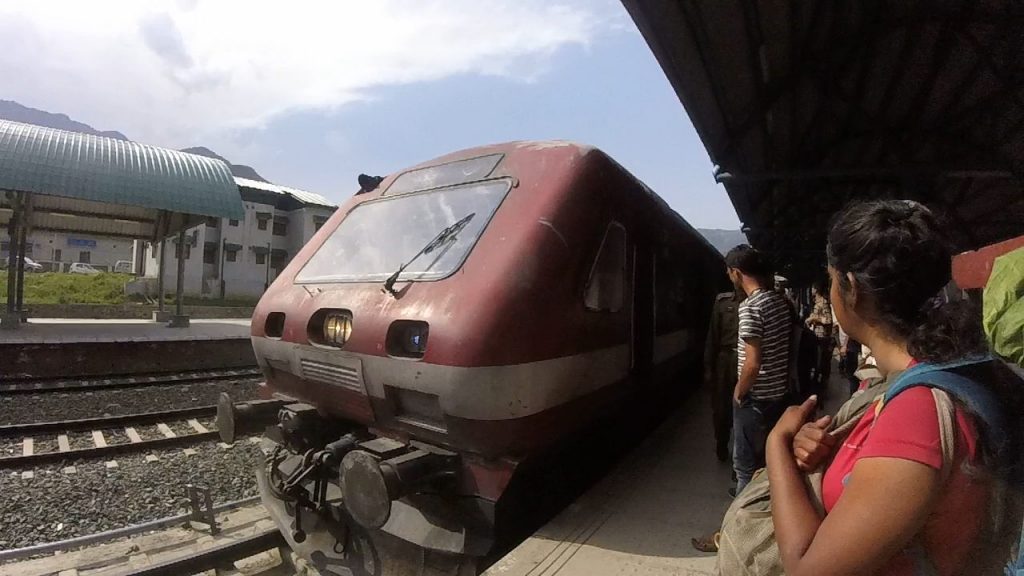When travelling across a country as vast as India, you can use one of many modes of transport. You can use the local buses, share taxis, railways and aeroplanes. Why, you can even hitchhike and find yourself in the back of a tractor. Or you can take you own or a rented car around the country. To make things adventurous and nimble, you can take your motorbike. For an epic workout, you can even use a bicycle for certain routes. In India 360, we used all the listed forms of transport. However in this post, we are going to talk about the most common and sustainable modes of transport that we used and tested extensively throughout the trip: public transport, self-driven car and self-driven motorbike.
Which is better?
Before we dive in, let us remind you that none of these modes is rated ‘good’ or ‘bad’. All of them work well in their own ways, but only one of them will usually work for your dream trip. Without getting into subjective debates on which one is better and childish debates on which one constitutes a ‘true backpacker’, ‘road-trip champion’ or a ‘dare-devil’, etc., let’s remember that all of them allow you to get from one place to another and explore the unique places, culture and people in the country. In the end, that’s all that matters. In India 360, we devised some objective and mathematical measurements to determine which one is the best for your preferred trip.
Measuring which transport is best for you
Availability
This is a measurement of how soon transport is available to you if you decide to go from point A to point B and how many times you have to switch before you make it to point B. Availability measures if the transport system is flexible enough to accommodate your dream travel itinerary or if instead you are having to bend your whole plan according to the available transport. It is a given that a self-driven car and a self-driven bike are ALWAYS available to you, as long as they are not in a garage undergoing servicing or repairs (will happen at least once, no overconfidence here!). Availability has to be measured more so for public transport.
If you want to travel from New Delhi to Ambala, a direct public bus is available at least once every 15 minutes. To travel from Thane locality to south Mumbai, a direct local train is available once every three minutes. In Chennai, to go from Besant Nagar beach to Kodambakkam, there is no frequent direct transport, but a city bus is available to Guindy railway station once every ten minutes and from there a local train to Kodambakkam once every five minutes. In these three cases, doesn’t matter when you leave your starting point, you will be on the next public transit within the next hour and on your way.
However, a public bus from Manali to Spliti in Himachal Pradesh runs only once per day, that too at 4 am. It is your lookout to wake up in the middle of the night, pack up and rush to the bus depot. You even need to book your seats a day earlier, standing in the queue of the bus depot’s ticket counter (no online booking available on that route), thus wasting precious time that could have been spent exploring.
Comfort
Depending on the quality of the route and the transport, a journey may be comfortable or a torture. The afore-mentioned Manali to Spiti route was a jerky nightmare when done by public bus, but later we were offered a lift in someone’s Duster (a brand of SUV). The shock absorbers of the Duster were amazing and the drive was incredibly smooth. Long drives in our car were a breeze compared to long rides on our motorbike due to back support. With a car, we could tirelessly drive upto 400 km per day, but we could only manage 150 on a motorbike. Hari has motion sickness, so all bus commutes in the Himalayas were a torture for him.
Cost-place-person ratio
The cheapest bus ticket from Mumbai to Ahmedabad costs ₹ 400. In contrast, we needed to fill up at least ₹ 2,000 of petrol in our Hyndai EON Magna before we reached Gujarat’s most vibrant city. In addition, the toll on the national highway NH-8 eats up another ₹ 1,000. The total cost jumps to a whopping ₹ 3,000. It is very easy to look at the absolute cost, i.e. 400 and 3,000 and instinctively conclude that bus is a MUCH cheaper and better option. Today, I will teach you to forget about absolute cost and think in terms to cost-place-person ratio.
On the way from Mumbai to Ahmedabad by car, we stopped by the Narmada river park in Bharuch, saw the Dandi beach, saw 6 places in Vadodara city, 2 places in Surat, 2 Amul-based workshops at Anand and also visited 6 places in Ahmedabad city. Spending just ₹ 3,000 on transport, we saw 18 sight-seeing destinations. That works out to ₹ 166 per destination. If you take the bus from Mumbai to Ahmedabad, barring a meal break in Surat, there are no other stops. For ₹ 400, you get to see Surat bus depot and Ahmedabad bus depot, at ₹ 200 per destination, already costlier than the car and not having seen anything important!
What if you wanted to see all the destinations that we saw along the way. You’d have to break your journey into several bus trips. Mumbai – Surat, Surat – Navsari, Navsari – Dandi and back, Navsari – Bharuch, Bharuch – Vadodara, Vadodara – Anand and Anand – Ahmedabad. And I have not yet considered city bus / auto rickshaw trips within Vadodara, Anand and Ahmedabad for local sight-seeing. Do you still think that you’ll spend only ₹ 400? Well, it works out to more than ₹ 3,000! And there’s the need to find bus timings, connecting buses, etc.
Let’s consider one more factor that makes public transport exorbitant. At ₹ 3,000, both members of India 360 travelled in one car, sharing petrol and toll costs. So the per-head, per-destination cost from Mumbai to Ahmedabad was a measly ₹ 83. Our car can accommodate 4 persons comfortably, so we could have added more people to India 360 and driven the per-head, per-destination cost to ₹ 42. If you were to travel as a gang of 4 by public transport, instead of costs getting divided, they will multiply as you pay fare for more persons and seats.
Before deciding a mode of transport, consider the places you want to cover along the way and how many people are taking the trip. With that, work out the per-head, per-destination cost. Public transport is usually cost-effective on a point-to-point basis with less people travelling.
Effects on body
Travelling by public transport can be a restful experience, since someone else is driving for you. A driver, motorman or a pilot. You can let your guard down and take a nap. Driving a car is the next best experience especially if your group is sharing the driving. The driving person needs to stay alert while the others can ease off. On a motorbike, neither the rider, nor the passenger can afford to doze off, nor can they sit in certain positions, e.g. stretched legs and leaning back, because those positions are hazardous for the balance of the motorbike. That said, motion sick people will prefer the hassles of driving rather than vomiting their guts out in a bus / SUV.
Coverage
How much of a state can you cover by using a particular mode of transport? If you are in a state like Punjab or Tamil Nadu, public buses will probably cover as much as 80% ground. Last mile connectivity will be in the form of shared taxis or auto rickshaws. These states’ superior hub-and-spoke connectivity helps you cover a large area. Relying on public transit in a state like Mizoram is inadequate since they ply only on the main highways and not in the interiors. Most locals own cars and motorbikes and use those to get around. Public transport will probably only allow you to see 20% of Mizoram. That said, sometimes cars are also not sufficient. Given the current road situation in states like Nagaland, Arunachal Pradesh or Manipur, a car with a low ground clearance will get hurt severely, requiring substantial repairs. in north-east India, good coverage is only possible through a motorbike or a very strong four-wheel driven SUV.
Now that we have seen how to measure the suitability of which transport mode works best for your trip, let’s see the three modes of transport we used in India 360, and the pros and cons of each.
Public transport
We have heard good things about public transport in Europe and terrible things about them in United States, where every adult in a family has to own a car. In India, the situation of public transport varies by region. States like Punjab, Tamil Nadu, Uttarakhand and Karnataka have a meticulously connected hub-and-spoke bus network, making it easy to hop from one bus to another to cover districts, cities, villages and places of interest. States like Mizoram and Chhatisgarh are not good at it at all, with nearly everyone requiring some private form of transport, like their own motorbike or car. States like Maharashtra and West Bengal are somewhere in the middle, with cities like Mumbai and Kolkata having ample public transport in multiple forms even late at night, but some other cities like Pune not having enough to cover the entire city.
Pros
By using public transport, you do not need to take your vehicle along, watch over its safety, maintain it, fuel it or find parking space.
There is a scope for activities such as one-way treks where you enter the route at one place, but exit at another, e.g. Sandhan Valley in Maharashtra or Rupin Pass in Himachal Pradesh. You don’t have to return to a place where a personal vehicle is parked. You can move on from the route’s exit point.
No matter how exhausted you are, once you enter a mode of public transport, you can relax and even take a nap while someone else is driving you to your destination.
Cons
One disadvantage is that usually the cost in public transit is per head. The costs usually multiply with the number of persons taking the trip.
Public transport has a fixed route and will take you only where their route goes. A bus from Mumbai to Khopoli will not take you all the way to Zenith waterfall, since the bus terminates at Khopoli’s bus depot. You need to take another transport for the 6 km from the bus depot to the waterfall. Also, an SUV shared taxi from Tezpur to Tawang will not stop and wait for you while you explore the Dirang monastery along the way. It is upto you to alight at Dirang and let the first taxi proceed without you. You need to catch another taxi to proceed to Tawang.
In some regions, you need to be aware of the timings of public transport, because they run only once every day or only certain days every week.
After you alight from one mode of transport, you need to carry your luggage with you while sight-seeing or trying to find a lodge. So you need to watch the weight of your luggage and make sure that it does not drag you down.
Extreme weather conditions, public strikes or holidays can shut down public transport and leave you stranded.
Car

A car can take you to off-beat places not covered by public transport, as long as there is a good road leading to those places.
This is the best mode of transport if you are covering the north Indian plains, peninsula or the parts of Himalayas with good roads. But driving a car is not recommended if you are covering Kashmir’s northern parts or Ladakh unless your vehicle is a 4-wheel driven SUV. A four-wheeled vehicle recommended of any power is not recommended if you want to cover Arunachal, Nagaland and Manipur. The roads there aren’t wide or developed enough to allow two cars / SUVs to cross paths without several adjustments.
Pros
A car provides you with ample space, both for seating and for luggage. Even our tiny EON Magna was very comfortable and allowed us to buy new clothes and to carry a tarpoline and a two-man Quechua tent.
In a car, the driver and the passengers can sit comfortably without damage to the body. You need to schedule stops and take breaks to stretch your legs. But those stops naturally happen when you pull over for your next sight-seeing destination or at the home of your hosts or a guest house.
Hell, sometimes you don’t even need a guest house or hosts. There were 4 days in the trip when we couldn’t find rooms in our budget or we ended up really late at our destination town. On one occasion, we were in the middle of nowhere. At such times, you can simply pull over, draw your car seat back and sleep for the night. Your car can double up as your place for stay.
During our honeymoon in Bhutan and in several states in India 360, we helped small children reach schools, elderly women reach marketplaces and forest officers reach town centres. A car gives you the opportunity to help the locals by giving them lifts, along with their luggage, and build relations with them.
With a car, you can take every road that leads somewhere. This is unlike a public transport vehicle whose routes are fixed and you’d have to miss places which are away from that fixed route.
A great advantage of a car is weather-proofing yourself. You are always protected from getting wet in the rain, you can crank up the air-conditioning in the summer and roll up the windows when the cold winter wind strikes.
Cons
The biggest headache with a car is summed up in one word: Parking. We faced mammoth parking problems in cities like Bengaluru (by far the worst region in India to drive or park), Kochi and Thiruvananthapuram. You’ll find yourself commuting 10 – 15 minutes to find parking space before your sight-seeing begins.
You cannot book luggage space on trains to carry cars. If you want to go from place A to place B, you’ll have to drive. Piggybacked rides are hard to come by with a car even if you have no desire to drive.
It doesn’t matter how tired you are, the person who is currently driving the car needs full alertness and cannot afford to doze. He/she can only rest when it’s not his/her turn to drive.
You can abandon a broken-down public transport vehicle, move on and find another one. A broken down motorbike can be pushed for a while or loaded in empty trucks. But a broken-down car needs to be towed. Help can arrive really late, depending on where you are in India.
You cannot risk your car, especially if it has low ground clearance, on the dismal quality roads in Ladakh, Spiti, Arunachal, Nagaland and Manipur.
Motorbike

A motorbike can be taken to difficult roads or even trails. They give you the deepest coverage of India — but at the cost of wear and tear to your body.
I start with a HUGE disclaimer. Riding a motorbike for several hundred kilometres per day for four months (Yes! 120 days) in a unrelenting sequence is not everyone’s cup of tea. Sure, young motorbike riders start with innocent enthusiasm and a feigned ‘badass’ look in their eyes from cities like Mumbai, Pune, New Delhi and Bengaluru every year. But usually they go with bike riding groups with dedicated mechanics and a lead rider who shows them the entire route. The carefully curated trips, which are made extremely safe by the organisers, are wrongly called ‘expeditions’ (wannabe ‘badass’ riders, please look up the real meaning of the word ‘expedition’ in the dictionary before you abuse its meaning. What you are doing is an ‘excursion’). Such trips last a short while, maybe 10 – 11 days, a month at most.
If you have done such a protected trip, do not assume that you have what it takes to ride around India for four months with luggage in tow and your spouse with you. It is exhausting physically and mentally. Your back, shoulders and legs beg for mercy. It is petrifying to just imagine how you are going to make it through the day, with you and the person you love the most in the world, safe after the day’s ride. And no, there is no tent or resort accommodation waiting for you with a warm cup of tea and dinner when you reach the destination at the end of the day. No, when you reach your destination, you need to hunt for budget lodges to find a bed for the night, search restaurants for dinner, find a way to care for the wear and tear on your motorbike and probably wash your clothes. In the morning, you tie all your luggage to the bike and start all over again! We did this everyday from February to May!
Here is the good part. If you want to cover north-east India, Ladakh and Spiti, then motorbikes are by far the best way to go. Especially if you want to explore unique villages that are off the tourist routes. Public transport don’t go there and a car simply cannot get there due to the conditions. You can do things on your trip that only a motorbike will allow you to. And that makes the effort worth it.
Pros
Motorbikes are small and nimble. You can cut through traffic, take difficult corners and keep moving.
We drove an Avenger 220 cc for the trip. The mileage of that motorbike is extremely high as it topped 50 kmpl at certain places. This offers you the best cost-place-person ratio. Your sight-seeing trip will cost peanuts. I cannot vouch for the same advantage if you are riding an Enfield, but it would still cost less that taking a sedan.
You can book motorbikes into the luggage compartment of a train and cut your riding time, going straight to the places where you really need to ride. In case of defects, you can flag a nearby truck to carry your motorbike for you to the nearest garage.
While a car goes wherever there are roads, motorbikes can even go into trails. The coverage of places you can achieve with a motorbike is the highest among all the three modes of transport. That’s why we could cover a large chunk of north-east India.
Cons
While you need to be alert while driving a car so that you don’t cause harm to others on the road, on a motorbike, you need to be alert just to keep your balance.
You don’t have to drive public transport. Driving a car across different weathers doesn’t take several adjustments to your driving skill. Not so with a motorbike. Your skill while driving on the highway is different from that of a city. You need to know how to ride in a cross wind. You need to know how to ride safely in rain. Hell, I had to learn how to ride on snow at Khardung La in Jammu Kashmir. And then really thick streaks of snow at Tawang in Arunachal Pradesh. Slush caused by rain in Manipur, Beds of gravel in Ladakh. Dirt left behind by roads washed away in Sikkim. Mud mounds left behind by landslides also in Sikkim. Every day teaches you a new skill when you are riding a motorbike cross-country, whether you are ready for it or not!
Among the three modes of transport, motorbikes take the highest toll on your body. Your back, shoulders and legs constantly face tests. All forms of weather assault you directly. Rain slaps your face, sun burns down your body and cold winds make your body numb. Luckily we never got caught in a hail storm!
Packing constraints are high. How much can you really carry on a motorbike? As much as your saddle bag or backpacks will allow you. Plus, you need extra gear like all-weather jackets, helmets, shin guards, knee guards, thermals, etc.
Conclusion
No transport takes a clear win when you want to cover all of India. Each mode has its advantages and disadvantages. Here is what I suggest.
If you are only interested in a point-to-point trip, where you cover big cities and towns, then you are better off with public transport. You need good focus and planning and the willingness to let go of places that won’t be covered by public transport. Let’s face it, public transport will only let you see India in scattered dots around the country. But you will make good relationships with local passengers in several states.
My favourite way is to take a car all around India, taking full advantage of the local flavour such as small shops, dhabas and off-beat locations. However, this is not possible in regions where road development is still catching up, mainly Spiti, Ladakh, Arunachal, Nagaland and Manipur. In these places I’d take a motorbike. But I’d use trains to carry the motorbike to the nearest terminus railway station from our desired location and start the ride from that railway station.


